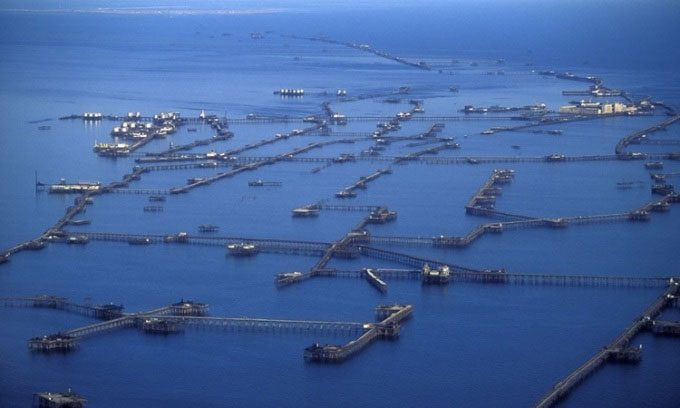The city of Neft Daşları (meaning “Oil Rocks”) spreads out like rusty tentacles on the surface of the Caspian Sea, far from the nearest land.
Neft Daşları is a network of oil wells and production facilities connected by kilometers of bridges in the Caspian Sea, the largest lake in the world. It is located about 96.5 km from the capital city of Baku in Azerbaijan and approximately a six-hour boat ride from the mainland. Neft Daşları is recognized by the Guinness World Records as the oldest offshore oil platform in the world. At its peak, the city was home to over 5,000 residents, according to CNN.

The city of Neft Daşları located in the Caspian Sea off the coast of Baku, Azerbaijan. (Photo: Reza).
The history of Neft Daşları began during the Soviet era. In the late 1940s, oil workers concentrated on a small island and built drilling rigs along with small houses for accommodation. The first exploratory well was drilled in 1949, successfully hitting an oil reservoir. The first oil tanker arrived onshore in 1951, marking the beginning of the city’s construction. The city of Neft Daşları gradually expanded, featuring iron pilings driven into the sea and situated just a few meters above sea level, as if floating. In fact, the city was created from nearly 2,000 oil wells and around 320 production facilities, linked by over 160 km of bridges and nearly 97 km of oil and gas pipelines.
Seven decommissioned vessels were brought to the area and sunk underwater. The wrecks form an artificial bay that helps protect the city from winds and ocean waves, even though Neft Daşları remains vulnerable to storms and rough seas. “Some ships can be seen from the surface where they were sunk,” said Mirvari Gahramanli, director of the Azerbaijan Oil Workers’ Rights Protection Organization.
In the following decades, Neft Daşları provided accommodation for workers, featuring a bakery, a theater with hundreds of seats, shops, medical facilities, a football field, and a helicopter landing pad. The city even had trees and a park on its steel structures. Some people in Azerbaijan refer to it as “the 8th wonder of the world” or “the island of seven ships.” The city was the center of oil production in the Caspian Sea, achieving nearly 180 million tons of oil over its 75 years of existence, according to SOCAR, Azerbaijan’s state oil company that owns and operates Neft Daşları. In its heyday in 1967, Neft Daşları produced a record 7.6 million tons of oil.
However, the city’s significance has declined in recent years due to the exploitation of larger oil fields and fluctuating oil prices. Production has dropped to less than 3,000 tons per day (approximately 1 million tons per year), according to SOCAR data from January. Production at Neft Daşları now accounts for only a small portion of Azerbaijan’s oil output, primarily aimed at the domestic market. Additionally, the city’s population has decreased to about 3,000 people, with workers typically working 15-day shifts at sea followed by 15 days at home on land. Under the impact of storms in the Caspian Sea, many areas of the city are in ruins. In 2008, several major bridge sections collapsed.
Authorities have also received numerous reports of oil spills causing pollution in Neft Daşları, with untreated wastewater flowing into the Caspian Sea. The future of this vast floating city, as oil reserves dwindle, has long been a pressing issue. Some believe Neft Daşları could become a tourist destination or museum, as the city is a cradle of offshore oil exploration and a part of Azerbaijan’s heritage.





















































